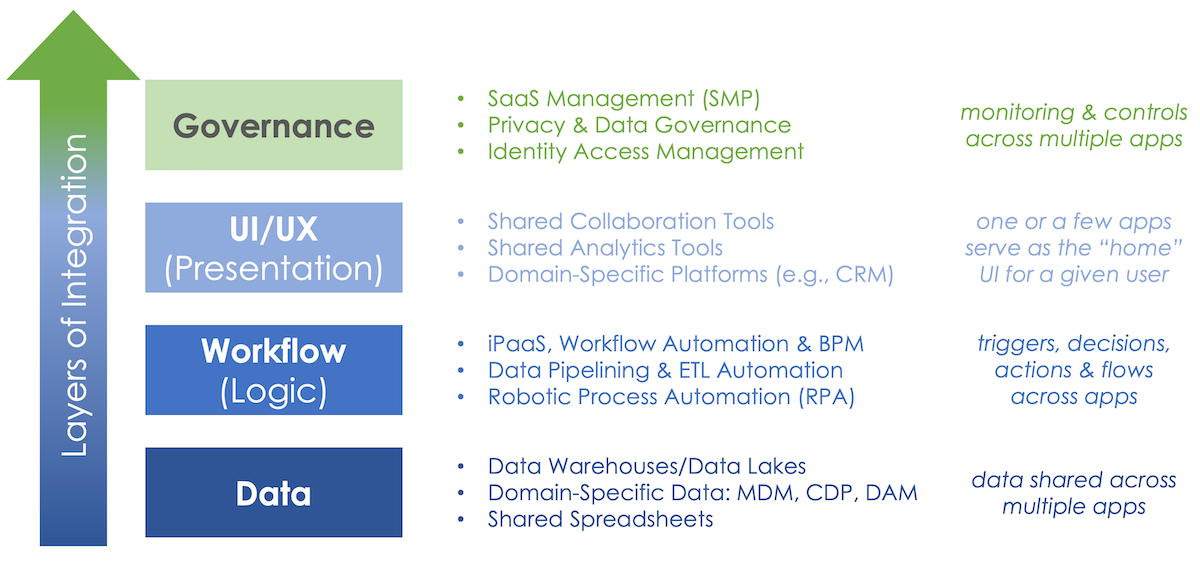The Great App Explosion can’t be stopped. But it can be harnessed.
A couple of years ago, I proposed a model of 4 layers of app integrations with SaaS platforms. Advocating for better integration, for marketing apps in particular, I pointed out that not all integrations are equal. They vary significantly in how deeply they’re integrated.
The 4 layers of integration that I described:
- Data — sharing data between apps, which is the most common kind of integration
- Workflow — automating activities across apps, most commonly triggers and actions
- UI/UX — embedding elements of one app in the user interface of another
- Governance — establishing and enforcing rules and standards in an app ecosystem
I still believe this is a useful model for individual SaaS platforms and their app ecosystems to strive for deeper integrations.
But as tech stacks continue to grow — not just in marketing, but in all departments and across them — I’ve been fascinated by the emergence of more and more products that span multiple, heterogeneous apps and create a kind of virtual platform layer across them.
The lightbulb turned on over my head when I attempted to map those app-spanning products into the 4 layers of my platform integration model, resulting in the illustration at the top of this post.
Virtual Data Layer
Companies with dozens or hundreds of apps are now aggregating data from all of them into data warehouse/data lake products such as Snowflake. They are using CDPs like Segment to share customer behaviors across different apps. And Excel and Google Sheets are universally used to work with small data sets, pulling and pushing data from many different apps too.
Virtual Workflow Layer
iPaaS and workflow automation tools, such as Workato and Zapier, have been widely adopted to automatically sequence activities across apps. A “trigger” occurs in one app — such as a new customer signing up on your website — and then your iPaaS/workflow automation tool can execute a series of “actions” across other tools in your stack. Any webhook can be a trigger; any API can be an action.
Most of these workflow automation tools are packaged as no-code solutions, which enable anyone in marketing ops — or even individual marketers — to create and modify automations in their work.
Virtual UI/UX Layer
Slack and Microsoft Teams have become ubiquitous. Whatever other apps you have open in your day-to-day work, it’s very likely that you have one of those open too. Both products are open platforms that let other apps embed features in their conversational UIs. Integrations range from simple notifications to pop-up modal dialogs, as well as adding new commands that can take actions in those other connected apps.
The result: disparate kinds of apps all share a common UI/UX within Slack and Teams.
Virtual Governance Layer
Finally, at a layer above, there is now a rich collection of tools that help govern all these different SaaS apps. Tools like Okta provide identity management and access control. SaaS management platforms (SMP) such as Blissfully and Torii keep track of all your different software subscriptions, manage onboarding and offboarding for users across a toolset of multiple apps, optimize SaaS spending and usage, and more.
Tools such as Dynatrace monitor the performance of your apps and cloud infrastructure. And tools such as OneTrust manage privacy, security, and data governance across apps.
Essentially, the tools at these different layers tame the chaos of large, diverse tech stacks.
Instead of trying to dramatically reduce the size of your stack, these tools make sure that your data can be aggregated, your cross-app processes can be automated, the number of UIs that an individual user has to jump between on a daily basis can be consolidated, and that good governance can be enforced — without having to converge on a single vendor platform.
There’s complexity — many different apps, delivering their own special capabilities to the different users who need them. But it’s manageable complexity, not chaos.
I expanded the model to include a bunch of other apps at each of these layers, as I think there are now many products enabling this stack-as-a-virtual-platform environment. But they tend to all share three characteristics:
- They are the canonical service for a particular capability in your stack, e.g., your data warehouse (Snowflake), your workflow automation platform (Workato), your messaging/collaboration app (Slack), your data governance tool (OneTrust), etc.
- They have open APIs and integrate with almost everything else in your stack.
- They’re agnostic about the other apps and platforms in your stack. For instance, they don’t care if you prefer HubSpot or Salesforce for your CRM.
There’s still enormous value to domain-specific platforms that incorporate these 4 layers of integration across their own ecosystem. A lot of this comes down to the platform where given roles in an organization spend most of their day. For marketing and sales, that is likely a CRM platform such as HubSpot or Salesforce. For IT service managers, it might be a platform such as ServiceNow or Zendesk.
But those platforms are increasingly citizens in a larger and more heterogeneous “virtual” platform of an organization’s entire tech stack.






